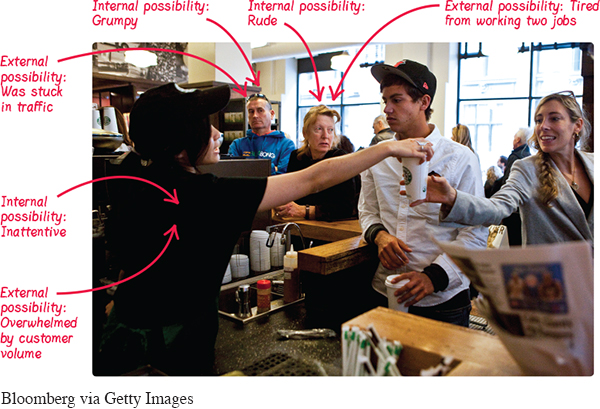Attributions and Perceptual Errors
Following the perception process, you often want explanations for why things are happening the way they are (“Why is Tom not talking during the meeting?”). These explanations are known as attributions. Two types of attributions are commonplace. One is that external factors or events—
Given the number of people you communicate with each day, it’s not surprising that you occasionally form invalid attributions. One common mistake is the fundamental attribution error, the tendency to attribute others’ behaviors to internal rather than external forces (Heider, 1958). You make the fundamental attribution error because when you communicate with others, they—
The fundamental attribution error is the most prevalent of all perceptual errors (Langdridge & Butt, 2004). For example, communication scholar Alan Sillars and his colleagues found that during conflicts between parents and teens, both parties typically fall prey to the fundamental attribution error (Sillars, Smith, & Koerner, 2010). Parents commonly attribute teens’ communication to “lack of responsibility” and “desire to avoid the issue,” whereas teens attribute parents’ communication to “desire to control my life.” Similar patterns have been observed during marital conflicts, with spouses typically blaming each other for the fight and attributing negative partner behaviors to internal causes: for example, “He’s so stubborn!” and “She’s so picky!” (Sillars, Roberts, Leonard, & Dun, 2000).
A related error is the actor-
However, when your actions result in success, you tend to take credit for the success by making an internal attribution (“The audience paid attention because I’m a skilled speaker”). This tendency is known as the self-
Your attributions directly influence how you communicate with others and the outcomes that result. For example, imagine that your partner forgets to pick up your dry cleaning on the way home from work. If you attribute your partner’s forgetfulness to work pressures and a hectic schedule (external causes), you’ll probably communicate in a supportive way (“I know how busy you are—
FUNDAMENTAL ATTRIBUTION ERROR
The morning rush at a coffee shop can be equally frustrating for customers and employees. Think about how their interactions might change if they considered external, rather than internal, attributions for one another’s behaviors.
